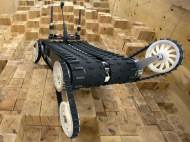QUINCE search and rescue robot developed in Japan
 A research group, consisting of people from International Rescue System Institute, Chiba Institute of Technology and Tohoku University, has developed a rescue robot named QUINCE. It will be used to collect rescue information in case of Chemical, Biological, Radiological and Nuclear (CBRNE) disasters, including hazardous substance leaks in the underground malls or tall buildings, and chemical agents terrorist attacks.
A research group, consisting of people from International Rescue System Institute, Chiba Institute of Technology and Tohoku University, has developed a rescue robot named QUINCE. It will be used to collect rescue information in case of Chemical, Biological, Radiological and Nuclear (CBRNE) disasters, including hazardous substance leaks in the underground malls or tall buildings, and chemical agents terrorist attacks.
The achievement was produced by a research and development that has been conducted since 2006 as a part of the Strategic Project on Advanced Robot Component Technology Development by New Energy and Industrial Technology Development Organization (NEDO). In a time of disaster, newly developed QUINCE runs at high speed through hazardous underground malls to help specify locations of potential victims, inspect a situation and provide information by remote control.
QUINCE can respond to both of disaster sites that require simple low-floor robots with high mobility and those that require high sensing abilities, by adopting a reconfigurable design concept by which basic functions and optional advanced functions are separated. QUINCE is able to move over various terrain including stairs and rubble piles. It is dustproof and waterproof so it is easy to decontaminate the robot after inspection of potentially hazardous areas.
The robot keeps functioning even if it goes through an unanticipated drop from a high place. QUINCE has four sets of wheels, each driving a tank-like rubber track and powered by a total of six electric motors, enabling the machine to roll over bumps and up and down slopes as steep as 82 degrees.
It has a camera, microphone, Position Sensitive Detector (PSD) sensor, Laser Range Finder, Wi-Fi and Infrared Thermography camera and carbon-dioxide sensors to help it find survivors by detecting body heat and breathing. QUINCE’s size is 655 x 481 x 225 mm (roughly 26 x 19 x 9 inches) and it weights 26.4 kg (58.2 pounds). Aside its ability to calculate three-dimensional shapes of substances or spaces, it is able to record integrated information from multiple robots and integrate it into overall 3D map.
QUINCE also features a robotic arm that can be controlled remotely to turn doorknobs, maneuver through rubble and carry crucial survival items after an earthquake or other disaster. The robot can move at speed of 1.6 meters per second (3.58 miles per hour). People trapped under rubble are able to hear the voices of rescuers through a speaker attached to the robot.
Eiji Koyanagi, a robotic engineering expert at Chiba Institute of Technology, told that the fire department of Chiba City, east of Tokyo, will test the QUINCE prototype starting next month.









Leave your response!